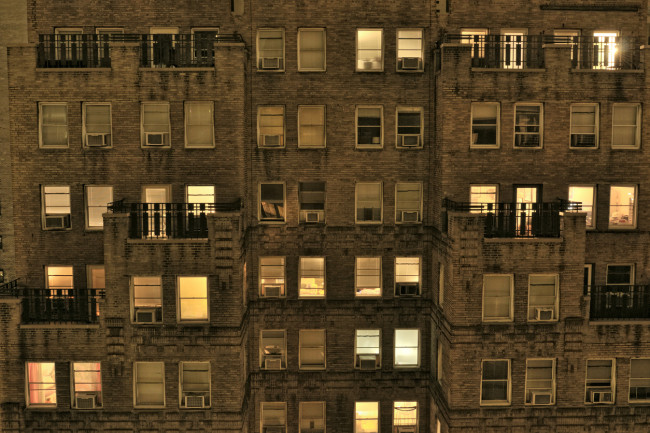What the end of the ‘Frankenstein loophole’ means for NYC renters
- A new law reaffirms a handful of tenant rights, including the ability to inherit a rent-stabilized lease from family
- Now if you move into a ‘Frankenstein’ apartment, your rent is capped at the combined amount of the two units

A view of historic Tribeca buildings with ground floor retailers.
iStock
The end of 2023 heralded the passage of a substantial piece of New York state legislation shoring up the rights of rent-stabilized tenants and putting the final nail in the coffin of the so-called “Frankenstein” loophole, which allowed landlords to hike rents by combining apartments. But its language isn’t completely set in stone.
The bill, S2980-C, helps to eliminate ways a landlord can deregulate individual apartments or entire buildings, strengthens a tenant’s ability to uncover and challenge illegal rent hikes, and adjusts how a tenant’s family member can inherit a rent-stabilized lease.
While S2980-C scored Governor Kathy Hochul’s signature on Dec. 22nd, its final wording is still in flux. That’s because the governor and legislature are negotiating the legislation through a process called a chapter amendment, says Brian Kavanagh, the state senator who sponsored the bill alongside Assemblymember Linda Rosenthal.
Kavanagh expects the amendment to retain “the basic purpose” of the legislation, particularly when it comes to how it defines fraud during rent overcharge cases. [January 8th update: Chapter amendments introduced by the Assembly on Friday, January 5th, would establish that an owner had to “knowingly” commit fraud, though the legislature hasn’t yet voted on the changes, The Real Deal reported.]
As the law’s proponents and critics await its final language, there’s a lot that NYC renters need to know about how the legislation impacts their rights. Read on for the five key things the bill accomplished in its not-so-final form.
Frankenstein apartments and first rent
Frankenstein apartments don’t refer to those occupied by a mad scientist, or his monster. Instead, Frankenstein apartments are simply two rent-stabilized apartments that are combined together. The alteration previously enabled a landlord to charge whatever they want as the “first rent” of the new, joined unit.
The loophole allowed a landlord to skirt rent-stabilization rules that limit unexpected rent hikes, even after the passage of the Housing Stability and Tenant Protection Act (HSTPA) in 2019, which removed a handful of other ways a landlord could deregulate an apartment.
The Division of Housing and Community Renewal took an ax to the Frankenstein loophole in the fall. A November rule change agency capped first rents on newly combined apartments as the total rent of the two previous units, curbing a landlord’s incentive to join apartments together.
The new law reaffirms that change; for units combined after Nov. 8th, rents are capped at combined units. Plus, units created from at least one rent-regulated apartment will become regulated.
While this has practically been the case since November, the law helps protect the DHCR rule change from a lawsuit, says Ellen Davidson, staff attorney with the Legal Aid Society.
“The real estate industry has a lot of money to bring a lot of lawsuits,” Davidson says. “One of the good things about having this bill in statute form is if the landlords were thinking about bringing a lawsuit on the basis [that DHCR had overstepped its role], that's been taken away from them.”
If you’re moving into a so-called Frankenstein apartment, make sure to ask about the previous units’ rents to ensure you’re getting a fair deal, or order your rent history to make sure your unit wasn’t illegally deregulated. Apartments that a landlord renovated to grow or shrink in size can also have higher or lower rents based on the percentage change of the space, according to the legislation.
Fraud in court cases
If you suspect your landlord has billed you for more rent than is legal, you can file a rent overcharge case—a way to find your legally regulated rent and get back that extra cash.
Before 2019, NYC courts could consider the past four years of an apartment’s rental history to determine how to calculate a rent overcharge, but the HSTPA expanded that timeframe to six years. A 2020 court decision limited that timeframe again, restricting courts to considering only four years of rent to overcharges that took place before the HSTPA enacted.
A separate bill, S2943-B, would have clarified how long a tenant could look back into an apartment’s rent history, but Hochul vetoed the legislation on Dec. 22nd, City Limits reported. She echoed concerns of the bill’s opponents, such as Jay Martin, executive director of the Community Housing Improvement Program, who worried the legislation would have retroactively applied to property owners that hadn’t kept past rent histories because they weren’t required to do so.
But tenants who allege fraud can look back further into an apartment’s rent history, rather than just four years.
The new law—at least how it was passed on Dec. 22nd—expands the definition of fraud to include unlawfully deregulating an apartment or failing to register an apartment as rent stabilized after 2011, if it benefitted from a J-51 or 421-a tax benefit. It also curtails a precedent from another state court case: one that prevented tenants from alleging fraud if they could have gotten ahold of their state rent records and objected to past increases.
Barring any significant changes during the chapter amendment process, the law should allow tenants—even those in pending cases—to better “hold their landlords accountable for fraudulent behavior,” Davidson says.
Though not finalized yet, Kavanagh expects the amendment to mostly contain “technical changes” that “clarifying what fraud means” during rent overcharge cases.
At least for now, landlord and tenant advocates are in a proverbial waiting game. Martin, a vocal opponent of the legislation, has already started advising owners to keep track of their rent records.
“It is what it is, the law is passed,” Martin says. “Now, we're primarily focused on making sure we understand when the chapter amendments go through, how the law will interact with the current existing regulations and how the owners can comply with it.”
Registering apartments and fines
Every year, owners have to register their rent-stabilized apartments with the DHCR and let the department know how much they’re charging in rent. In the past, an owner could get hit with a late filing fee of $10 per unit, if a renter complained that they were overcharged.
S2980-C hikes that fine. Landlords who fail to file will get hit with a $500 penalty per unit for every month that the property owner doesn’t send in their annual rent registration statement.
“This is not intended to collect lots of revenue from landlords; it is intended to make sure that they're meeting their basic legal obligation to register their apartments,” Kavanagh says. “And that’s a very significant change.”
Succession rights
If you’re lucky enough to live in a rent-stabilized apartment, it’s possible for a family member—or other close relationship—to inherit your unit after you move out, under certain circumstances.
For example, to take over a rent-stabilized apartment from your mother, you would have to have lived in the apartment for at least two years before your mother moved out. If you’re disabled or older than 62, you only have to have lived with your mother for one year.
The law reaffirms that the one or two-year period is determined by when the primary tenant relocates, or passes away—something the DHCR accomplished in its November rule change. Previously if a tenant—scared of losing the apartment—didn’t inform their landlord about plans to inherit the space, they could lose the unit if their landlord sued for eviction, Davidson says.
“People were losing their right to succeed, because the tenant of record didn't understand the law,” Davidson says.
If you’re hoping to take over a family member’s apartment, it’s still best to make your intentions clear to your landlord—ideally before your relative relocates. You can send your landlord a formal notice in the mail. You should also document your residence by collecting mail or bills at that address, or having it listed on your identification, so you can prove you’ve lived there for the necessary amount of time.
Substantial rehabilitation
The new law allows a landlord to remove a “seriously deteriorated” building from rent stabilization if it undergoes a “substantial rehabilitation.” But it requires a landlord to get approval from the DHCR within one year of completing the renovation work. Buildings that weren’t in such bad shape, or that had a history of tenant harassment within the five years before the rehabilitation, will remain rent stabilized, according to S2980-C.
“These things are rare, but we wanted to make sure that if somebody is doing that work now, they can't 15 years from now say, ‘oh, I did that work in 2024 and as a result, [the building] isn’t rent regulated.’” Kavanagh says. “If they do the work in 2024 they're gonna have to tell DHCR that.”
The law mimics some of the regulations DHCR published in November, though the department included more specifics. For example, DHCR requires a substantial rehabilitation to include the replacement of at least 75 percent of the building’s systems.
This portion of the law may also undergo some technical changes as the governor and legislature negotiate chapter amendments, but Kavanagh says the “underlying purpose” of the legislation remains the same. The law only applies to future building renovations, he added.
You Might Also Like



























